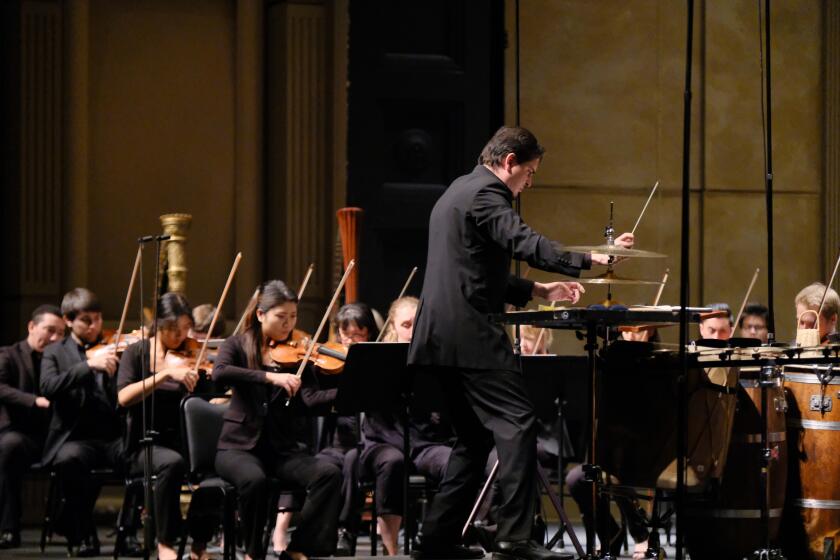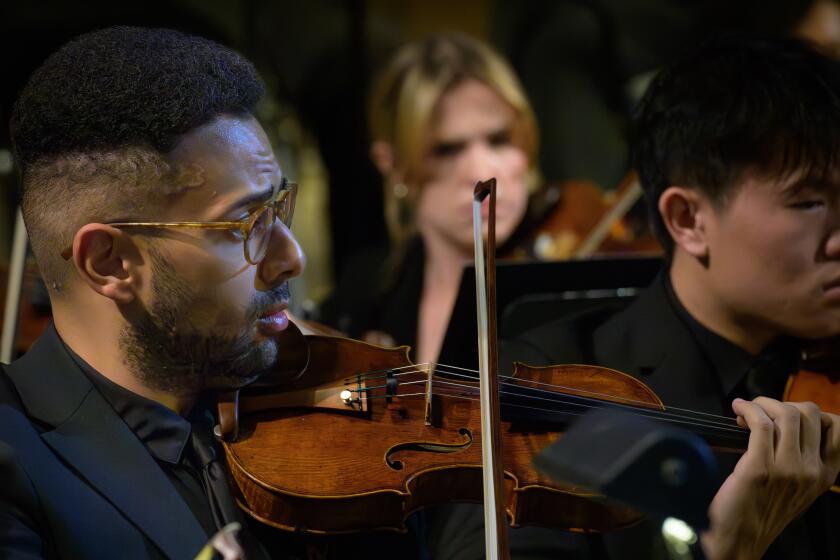De Mille--An American Original Returns to ABT
She is dressed all in black, a bow tying her hair back; a small, seemingly fragile figure in a wheelchair. The voice, however, is strong, the clear blue eyes darting everywhere, missing nothing.
She is Agnes de Mille and she is conducting a run-through of her new ballet about Anglo-Irish violence, “The Informer,” the first work she has choreographed for American Ballet Theatre in 13 years. It will have its world premiere March 15 at Shrine Auditorium in Los Angeles and will be repeated March 16.
The work has three principals, plus corps, but the corps members are not present today. They are busy rehearsing the new production of “Gaite Parisienne” elsewhere in the lavish rehearsal studios on lower Broadway.
At this advanced rehearsal the soloists get few instructions. They have already learned their steps; the movements are fluid and natural. De Mille’s face is intense as she nods approval of a mimed cry of pain and horror. She inhales audibly and her arms rise as two consecutive one-armed lifts are executed perfectly.
De Mille, 82, has her own assistants at the rehearsal. Terry Orr, a ballet master of ABT, is here to coordinate matters. De Mille’s designer, Santo Loquasto, has costume sketches spread out on the floor for her approval. (Later he recounts how she asked him to her apartment to see a post-Expressionist painting she owned. “ ‘Look at these gray washes, lavenders and earth tones,’ she said. ‘That’s what I want in your designs. Something atmospheric and poetic, not literal.’ ”)
Martha Johnson, the rehearsal pianist and a De Mille friend of 30 years, speaks to her about the music--Celtic folk dances and songs: “Can I change from D minor to E minor for variety at this point?”
The orchestrator, William D. Brohn, asks De Mille, “Where does that bell you want come in?”
Brohn is impressed with De Mille’s sensitivity to orchestral sounds. “She cuts through the crap,” he says later. “When she asks for drums, she wants military drums to convey a threat hovering in the air. As for the bell, she wants a church bell to suggest funerals, not a chime or a synthesizer. Those little values of hers make a difference.”
The three principals are warming up after inspecting a wanted poster, which is a key prop. Kathleen Moore, her ballerina, joined ABT only in 1982. Johan Renvall has been with the company 10 years, while Victor Barbee, who dances the title role, is the veteran with 13 years’ service. All show obvious affection and devoted respect for the choreographer as she puts the dancers through their paces.
At one point, De Mille turns to a visitor and asks: “Was that movement clear? God knows it’s simple enough!” Perhaps she has summed up the elements she has always mined so well--clarity and simplicity in the service of drama.
After the rehearsal, De Mille tells the visitor: “You have no idea how difficult it was (to create “The Informer”). Dancing is so technical. Now I have to verbalize it. I’m like a mathematician and it has all taught me the value of words. I can’t make a move without my assistant, Mary Beth Griffith. She’s an expert on Irish dancing and has trained the dancers for style. If I say I want a vertical movement, with a change in rhythm, she shows them if there’s a problem.”
But ballet master Orr says: “There’s nothing new in her (use of) verbal description, rather than demonstration, of what she wants. She worked like that 20 years ago. Occasionally, a corps member, not used to her style, might need to be shown. Otherwise, things have come together quite easily. Mr. (Antony) Tudor was a verbal choreographer also.”
De Mille says she is pleased with her cast, but is otherwise appalled at the general attitude and training of the youngsters today: “When I spoke to them about decorum in the rehearsal hall, they didn’t know what I was talking about! I said at one point, ‘Don’t stand there doing your battements. You should be in the story even if you’re not on stage.’
“Everyone is taught technique, but no one is taught about acting. ‘Rodeo’ is my most difficult ballet. It requires five comedians. How is that going to be done (with today’s ABT dancers)? No one knows the quality of movement. I want theater! Do you know that marvelous Martha Graham phrase, ‘Blinded by the zenith’?
“I tell them, ‘Watch people on the subway, how they use their hands, their heads.’ I’m not talking about beauty per se. Dress dummies can be beautiful. I want someone like Nora Kaye, who came out of the corps--(Alicia) Markova was great--and someone creamy like (Margot) Fonteyn.
‘Juno’ an Inspiration
Although she was moved by the power of the 1935 John Ford film classic “The Informer,” with Victor McLaglen, De Mille says the germ of her ballet was planted when she was choreographing the musical version of “Juno and the Paycock” for Broadway. It was called more simply “Juno” back in 1959.
“I was always interested in Irish music and the incredible tragedy of the Irish situation from the time of ‘The Troubles’ to the present day. I take no political stand,” she says.
“My grandfather always used to say that, in the 1880s, the whole thing boiled down to possession of the land, both by the English and the Irish. The big absentee landowners controlled everything. The poverty was awesome and it’s not much better now.
“The story of the ballet is easy enough to follow. It’s a triangle--the young man who’s a worn-out, maimed fighter, only wanting to get away with the woman he loves; his rival, whom the British want to capture, and the girl who cares for neither of them as much as she does for Ireland.”
Mikhail Baryshnikov, the artistic director of American Ballet Theatre, says, in a separate interview, that the ballet was commissioned for the company’s 50th anniversary in 1990. “I wanted to do a new production of ‘Rodeo,’ one of Agnes’ biggest successes,” he says. “When we met to discuss it, she suggested instead a new work. She made me an offer I couldn’t refuse.
“I had first seen her work when ABT came to Leningrad in the ‘60s--’Rodeo’ and ‘Fall River Legend,’ I believe. Then in 1979 I saw a production of ‘Oklahoma!’ in New York.
“I know it’s a cliche, but it’s a true one that Agnes de Mille is the most American of all choreographers. She hadn’t done a new piece for us in over 10 years. I was very excited at the prospect.
“She’s a trip and a challenge. She has an incredible mind. She knows her subjects 200%. She had directed me when I did the Devil in her ‘Three Virgins and a Devil’ in 1983. She accomplishes more from that wheelchair than most other choreographers do running around all over the stage.”
De Mille’s dancers would seem to agree with the Boss. On rehearsal breaks, the three dancers are enthusiastic as they speak individually of the tasks at hand.
“Thank God, for once I don’t have a hand-me-down (role),” Barbee says. “I get to work with a creator and do a part that wasn’t created for someone else. It’s like doing your own cooking instead of depending on someone else’s recipe.
“Miss De Mille is specific about what she wants, but she allows you to have input, gives you some leeway. She leaves some things vague to see what you’ll do with it so the audience will feel it’s coming from you. She gives atmosphere, we interpret.”
This kind of method obviously appeals to Barbee, who once got an acting job as a Soviet defector on the “Hart to Hart” television series by reading the Gideon Bible over the phone in a Slavic accent for the producer.
Moore is of the same mind as Barbee about the rehearsal process. “My doing this work means that there won’t be any ghosts in the closet,” she says, referring to the fact that as a dramatic ballerina she usually has to contend with the memories of her predecessors, Nora Kaye and Sallie Wilson, in such a work as Antony Tudor’s “Pillar of Fire.”
“I am more fulfilled in the dramatic stuff,” she says. “I had no experience in Irish dancing. Your arms are down and relaxed. You use the legs chiefly. This is a wonderful experience for me.”
“My part wasn’t difficult to learn,” says Renvall. “Miss De Mille wanted a jumper, so I got it. I had never done Irish dancing before. It can be a little tricky. You can end up kicking yourself in the butt. Miss De Mille knows exactly what she wants and she always gets her way.”
All three dancers, among others, were suggested to the choreographer by Orr and Baryshnikov to make things as easy as possible for De Mille. The final casting decisions, however, were hers.
“I’ve been treated superbly this time around,” says De Mille. “It was not always the case.” She refers to a few ballets she did during the regime of company co-founder Lucia Chase, but refuses to be specific, saying only, “I don’t want to get into that any more.”
It is difficult to believe she has not always been treated well because she is as close to an American legend as this country has produced. And what the legend is all about is theater rooted in the American past.
Uncle Cecil B.
The De Mille background was a typical American well-born, comfortable one. Her paternal grandfather and father were successful playwrights, her maternal grandfather a distinguished economist. Her uncle was film director Cecil B. DeMille. Although New York born, she was brought up in Los Angeles, where she was graduated cum laude from UCLA in 1926.
Dance was all she ever wanted and, after college, she returned to New York to begin her career. Her most rigorous training, however, was to be in London where she was encouraged by British ballet pioneer Marie Rambert. She stayed in England from 1933 to 1938.
On one of her trips home, in 1936, she was engaged to choreograph the dances for the Norma Shearer-Leslie Howard “Romeo and Juliet” film for MGM.
In 1940 the newly formed Ballet Theatre asked her for a ballet called “Black Ritual,” and her long association with the organization began. Her first big success with the company came the following year with “Three Virgins and a Devil.”
Strangely it was for the Ballet Russe de Monte Carlo, not Ballet Theatre, that in 1942 she created “Rodeo,” which became almost her signature piece and assured her a place in the history books.
This charmer, with its pure American setting, brought her to the attention of Rodgers and Hammerstein, who asked her to do the dances for “Oklahoma!” It was a watershed musical and one of the major reasons was its integration of ballet sequences to further the story line.
“One Touch of Venus,” “Bloomer Girl,” “Carousel,” “Brigadoon,” “Gentlemen Prefer Blondes,” and “Paint Your Wagon” are some of the many Broadway musicals with which she was associated.
Returning to ballet in 1948, De Mille created one of her masterpieces, “Fall River Legend” (about Lizzie Borden) which helped confirm the stardom of the young Nora Kaye at Ballet Theatre.
During all this activity, the choreographer found time to marry musical impresario Walter Prude, produce a son, lecture, write 11 books, speak out on subjects in addition to theater and dance and be honored by Presidents Kennedy, Johnson and Carter.
In 1975 she was brought near death by a severe stroke. It came as no surprise to those who know and work with her that she fought back and won. She credits her doctors and therapists at New York Hospital, particularly Dr. Fred Blum. “They saved me,” she says.
“I’ve adjusted. My only problem is that I tire very easily. I have no staying power. Part of it is due to my condition and part my age.”
“You want more details on my recovery? Go read my book, ‘Reprieve.’ If you loaned it out, buy another one. It’s very good.” Since the stroke De Mille has done four ballets.
“There is just never enough time,” De Mille says, “although Misha (Baryshnikov) is very supportive.” Cautioned about budget restrictions, she blurts in her usual frank manner, “Why did you spend the money on that ridiculous Balanchine ballet (“Ballet Imperial”)?
“Baryshnikov is the best I’ve ever seen; you know, my friend Tamara Geva said he was better than Nijinsky. Generally the women are less interesting than the men.
“Of the choreographers today I like Eliot Feld and Paul Taylor. They aren’t giants like Balanchine, Tudor, Graham or Jose Limon, but they’re very good.
“I’m looking forward to coming to Los Angeles,” she says. “So many people to see in such a short time. Of course, the Shrine is an impossible theater. In the meantime I’m also working on two new projects. The first one is a book I can’t tell you about. The second is checking a new book by Anne Edwards for errors. She’s written a history of the De Mille family.”
Abruptly the conversation is ended. “I don’t think I can talk anymore now,” she says simply.
One wonders how long it will be before Agnes de Mille gives Baryshnikov or anyone else another offer he can’t refuse.
More to Read
The biggest entertainment stories
Get our big stories about Hollywood, film, television, music, arts, culture and more right in your inbox as soon as they publish.
You may occasionally receive promotional content from the Los Angeles Times.






